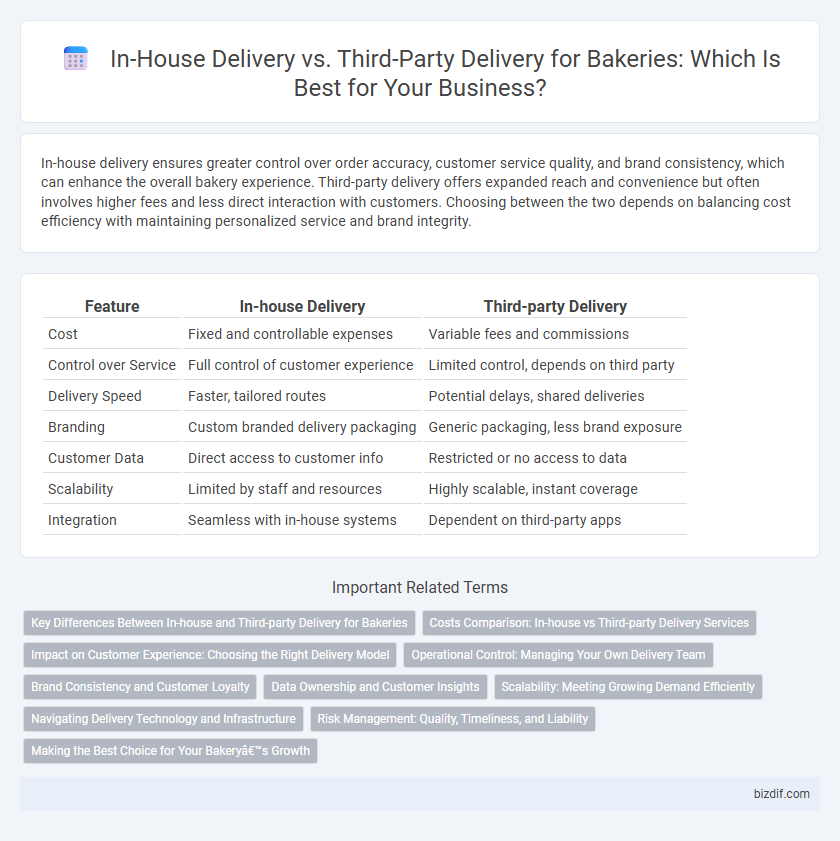In-house delivery ensures greater control over order accuracy, customer service quality, and brand consistency, which can enhance the overall bakery experience. Third-party delivery offers expanded reach and convenience but often involves higher fees and less direct interaction with customers. Choosing between the two depends on balancing cost efficiency with maintaining personalized service and brand integrity.
Table of Comparison
| Feature | In-house Delivery | Third-party Delivery |
|---|---|---|
| Cost | Fixed and controllable expenses | Variable fees and commissions |
| Control over Service | Full control of customer experience | Limited control, depends on third party |
| Delivery Speed | Faster, tailored routes | Potential delays, shared deliveries |
| Branding | Custom branded delivery packaging | Generic packaging, less brand exposure |
| Customer Data | Direct access to customer info | Restricted or no access to data |
| Scalability | Limited by staff and resources | Highly scalable, instant coverage |
| Integration | Seamless with in-house systems | Dependent on third-party apps |
Key Differences Between In-house and Third-party Delivery for Bakeries
In-house delivery for bakeries ensures complete control over order accuracy, packaging quality, and customer service, allowing for a consistent brand experience and timely delivery. Third-party delivery offers wider reach and convenience but involves higher fees, less control over customer interaction, and potential risks to product quality during transit. Analyzing factors such as cost, customer satisfaction, and operational capacity helps bakeries decide the most efficient delivery method.
Costs Comparison: In-house vs Third-party Delivery Services
In-house delivery incurs fixed costs such as vehicle maintenance, driver salaries, and insurance, which can be controlled but require upfront investment. Third-party delivery services charge variable fees, often 15-30% per order, reducing operational burdens but increasing per-sale expenses. Evaluating order volume and profit margins is essential for bakeries to determine the most cost-effective delivery model.
Impact on Customer Experience: Choosing the Right Delivery Model
In-house delivery allows bakeries to maintain direct control over order accuracy, packaging quality, and delivery timeliness, leading to a more personalized and consistent customer experience. Third-party delivery services offer broader reach and convenience but can introduce variability in service quality and limit the bakery's ability to manage customer interactions directly. Selecting the right delivery model depends on balancing control and scalability to ensure timely, fresh product delivery that meets customer expectations.
Operational Control: Managing Your Own Delivery Team
Managing your own delivery team provides complete operational control, enabling precise scheduling, quality assurance, and direct customer interaction. In-house delivery reduces reliance on external platforms, ensuring consistent brand experience and faster issue resolution. This control allows bakeries to optimize routes and maintain product freshness, enhancing customer satisfaction and loyalty.
Brand Consistency and Customer Loyalty
In-house delivery enables bakeries to maintain complete control over brand consistency, ensuring that packaging, product presentation, and customer service align with the bakery's standards. This personalized approach fosters stronger customer loyalty by creating a seamless and memorable experience that third-party delivery services often cannot replicate. Reliance on third-party platforms may lead to inconsistent brand representation and reduced direct customer interaction, potentially weakening long-term loyalty.
Data Ownership and Customer Insights
In-house delivery for bakeries ensures full data ownership, allowing direct access to comprehensive customer insights such as purchase behavior, preferences, and feedback. This data empowers bakeries to tailor marketing strategies, enhance product offerings, and build stronger customer relationships without sharing sensitive information with third parties. Third-party delivery platforms often control customer data, limiting bakeries' ability to analyze trends and personalize services effectively.
Scalability: Meeting Growing Demand Efficiently
In-house delivery allows bakeries to maintain direct control over order processing and quality, ensuring scalable operations tailored to specific customer needs. Third-party delivery services offer rapid scalability by leveraging established logistics networks and broad market reach without significant upfront investment. Choosing the right delivery model depends on balancing control, cost efficiency, and the ability to meet increasing customer volumes effectively.
Navigating Delivery Technology and Infrastructure
In-house delivery systems enable bakeries to maintain direct control over order accuracy, customer interaction, and timely fulfillment by leveraging customized delivery apps and dedicated staff. Third-party delivery platforms offer extensive reach and reduced infrastructure costs but often involve higher commission fees and less control over the customer experience. Efficient navigation of delivery technology requires bakeries to balance investment in digital ordering platforms, GPS tracking, and real-time inventory management against cost and service quality factors.
Risk Management: Quality, Timeliness, and Liability
In-house delivery enables bakeries to maintain strict control over product quality and timeliness, ensuring baked goods arrive fresh and on schedule, which minimizes customer complaints and preserves brand reputation. Third-party delivery services introduce risks related to inconsistent handling, potential delays, and ambiguous liability in case of damaged or spoiled products, complicating accountability. Effective risk management requires bakeries to weigh the benefits of direct oversight against outsourcing convenience while implementing quality checkpoints and clear liability agreements.
Making the Best Choice for Your Bakery’s Growth
In-house delivery offers bakeries full control over customer experience, enabling personalized service and ensuring product quality from oven to doorstep, which can enhance brand loyalty and increase profit margins. Third-party delivery services provide broader market reach and convenience without the need for extensive logistics management but often involve higher commission fees that reduce overall revenue. Evaluating factors such as delivery costs, customer satisfaction, order volume, and operational capacity helps bakery owners make the best choice to sustainably grow their business.
In-house Delivery vs Third-party Delivery Infographic

 bizdif.com
bizdif.com